
Akihito
Born into the oldest hereditary monarchy in the world, Akihito became the 125th emperor of Japan in 1990.
Synopsis
Akihito was born on December 23, 1933, in Tokyo, Japan, the eldest son of Emperor Hirohito and Empress Nagako. After officially being named heir to the Japanese throne in 1952, he was the first member of the Imperial family to marry a commoner. Akihito became the 125th emperor of Japan in 1990, and has since earned renown for his humanitarian gestures.
Early Years
Tsugunomiya Akihito was born on December 23, 1933, in Tokyo, Japan. The fifth child and eldest son of Emperor Hirohito and Empress Nagako, Akihito was in line to become the 125th emperor of Japan as scion of the oldest hereditary monarchy in the world.
In accordance with Japanese custom, Akihito was separated from his parents as a young boy and raised by chamberlains and tutors. He began his education at the Peers' School in 1940, but left Tokyo for his safety toward the end of World War II. During this time, he received lessons in the English language and Western customs by American author and librarian Elizabeth Gray Vining.
Akihito eventually returned to the Peers School in the late 1940s and enrolled at Gakushuin University in 1952, although he never received a degree.
Crown Prince and Emperor
In 1952, Akihito was officially invested with the title Kotaishi Denka, Crown Prince, and declared the rightful heir to the throne. Seven years later, he bucked a 1,500-year-old tradition with his marriage to Sh?da Michiko, becoming the first member of the Imperial Family to marry a commoner. They had three children together: Crown Prince Naruhito (born in 1960), Prince Akishino (1965) and Princess Sayako, aka Princess Nori (1969).
Following the death of Emperor Hirohito on January 7, 1989, Akihito accepted possession of the sacred sword, beads and mirror of the Sun Goddess Amaterasu Omikami as the rite of passage to the Chrysanthemum Throne. He officially became the 125th emperor of Japan on November 12, 1990, his reign designated "Heisei," which translates to "Achieving Peace."
Ceremonial Duties
With the emperor relegated to a symbolic role since the dissolution of the Japanese Empire after World War II, Akihito was credited with bringing a sense of humanity to the monarchy. Along with Empress Michiko, he visited dozens of foreign countries, offering apologies for Japanese imperialism in previous generations.
Further changes to tradition seemed imminent with Akihito in power: Some suggested eliminating the rule that only a male could ascend to the Chrysanthemum Throne, although the concept became less urgent after the wife of Crown Prince Akishino gave birth to Prince Hisahito in 2006. Akishino later suggested his father be allowed to retire and enjoy his remaining years, instead of ruling until his death.
Akihito's mother died in 2000, and the popular emperor soon began suffering from health problems as well. He underwent surgery for prostate cancer in 2003, and had coronary artery bypass surgery in 2012. Regardless, he continued to travel and take part in ceremonies as the public symbol of Japanese tradition and unity.
Following the devastation wreaked by the 2011 earthquake and tsunami in Japan, Akihito delivered a televised speech to provide a lift to his shell-shocked countrymen and visited survivors. Long interested in marine biology, he contributed a 350-page paper on Gobiodei, a Japanese fish, to an encyclopedia in 2013.




